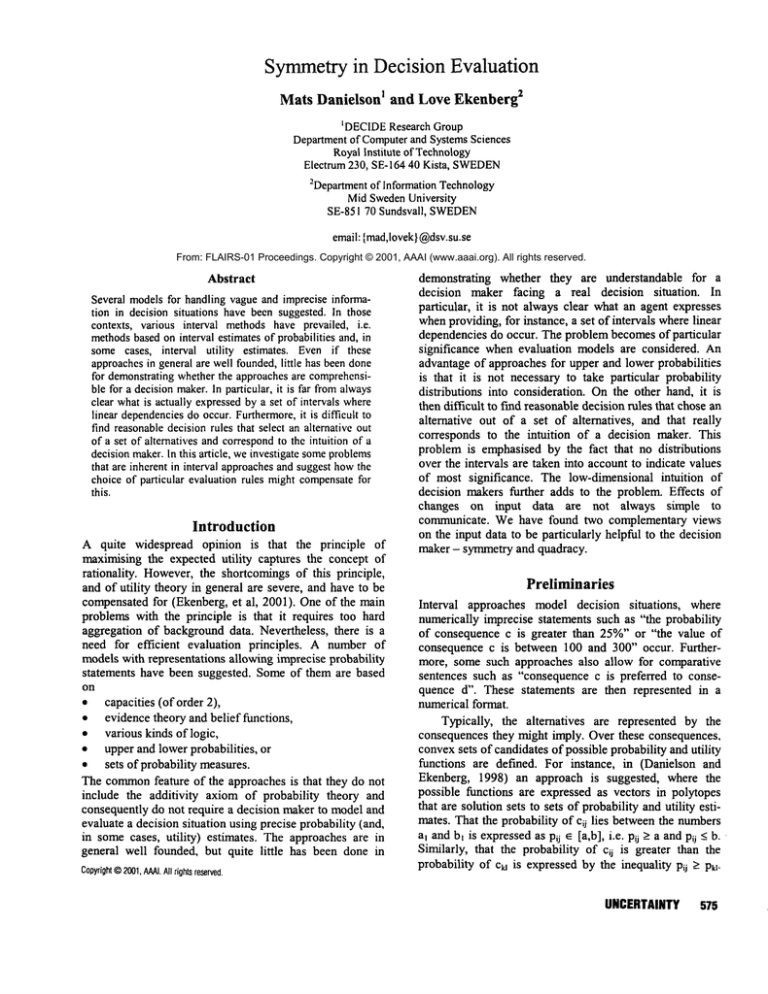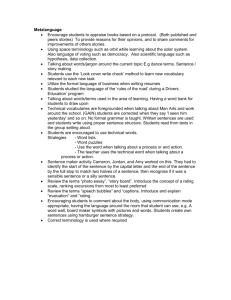
Symmetry
in Decision Evaluation
Mats Danielson i 2and Love Ekenberg
~DECIDE
Research Group
Departmentof Computerand SystemsSciences
RoyalInstitute of Technology
Electrum 230, SE-16440 Kista, SWEDEN
2Department
of InformationTechnology
MidSwedenUniversity
SE-85170 Sundsvall, SWEDEN
email: [mad,lovek}@dsv.su.se
From: FLAIRS-01 Proceedings. Copyright © 2001, AAAI (www.aaai.org). All rights reserved.
Abstract
Several modelsfor handlingvagueand impreciseinformation in decision situations have beensuggested. In those
contexts, various interval methodshave prevailed, i.e.
methodsbasedon interval estimatesof probabilities and, in
somecases, interval utility estimates. Even if these
approachesin general are well founded,little has beendone
for demonstratingwhetherthe approachesare comprehensible for a decisionmaker.In particular, it is far fromalways
clear whatis actually expressedby a set of intervals where
linear dependencies
do occur. Furthermore,
it is difficult to
find reasonabledecisionrules that select an alternative out
of a set of alternatives and correspondto the intuition of a
decisionmaker.In this article, weinvestigate someproblems
that are inherentin interval approachesand suggesthowthe
choice of particular evaluation rules mightcompensate
for
this.
Introduction
A quite widespread opinion is that the principle of
maximising the expected utility captures the concept of
rationality. However,the shortcomingsof this principle,
and of utility theory in general are severe, and have to be
compensatedfor (Ekenberg, et al, 2001). One of the main
problems with the principle is that it requires too hard
aggregation of backgrounddata. Nevertheless, there is a
need for efficient evaluation principles. A number of
modelswith representations allowing imprecise probability
statements have been suggested. Someof them are based
on
¯
capacities (of order 2),
¯
evidence theory and belief functions,
¯
various kinds of logic,
¯
upper and lower probabilities, or
¯
sets of probability measures.
The commonfeature of the approaches is that they do not
include the additivity axiom of probability theory and
consequently do not require a decision makerto modeland
evaluate a decision situation using precise probability (and,
in some cases, utility) estimates. The approaches are in
general well founded, but quite little has been done in
Copyright
©2001,
A/~I.All riohlsreserved.
demonstrating whether they are understandable for a
decision maker facing a real decision situation.
In
particular, it is not always clear what an agent expresses
whenproviding, for instance, a set of intervals wherelinear
dependencies do occur. The problem becomesof particular
signifcance when evaluation models are considered. An
advantage of approaches for upper and lower probabilities
is that it is not necessary to take particular probability
distributions into consideration. Onthe other hand, it is
thendifficult
tofredreasonable
decision
rules
thatchose
an
alternative
outof a setof alternatives,
andthatrcally
corresponds
to theintuition
of a decision
maker.This
problem
is emphasised
by thefactthatno distributions
overtheintervals
aretaken
intoaccount
toindicate
values
of mostsignificance.
Thelow-dimensional
intuition
of
decision
makersfurther
addsto theproblem.
Effects
of
changeson input data arc not alwayssimple to
communicate.
Wc havefoundtwo complementary
views
ontheinput
datatobeparticularly
helpful
tothedecision
maker- symmetry
andquadracy.
Preliminaries
Interval approaches model decision situations, where
numerically imprecise statements such as "the probability
of consequence c is greater than 25%"or "the value of
consequence c is between 100 and 300" occur. Furthermore, some such approaches also allow for comparative
sentences such as "consequence c is preferred to consequence d". These statements are then represented in a
numerical format.
Typically, the alternatives are represented by the
consequences they might imply. Over these consequences,
convexsets of candidates of possible probability and utility
functions are defined. For instance, in (Danielson and
Ekenberg, 1998) an approach is suggested, where the
possible functions are expressed as vectors in polytopes
that are solution sets to sets of probability and utility estimates. That the probability of c~j lies betweenthe numbers
al and b~ is expressedas Pij e [a,b], i.e. P0 > a and Pij < b.
Similarly, that the probability of c~j is greater than the
probability of Ckj is expressed by the inequality Pij > Pu.
UNCERTAINTY 575
Each statement is in this way represented by one or more
constraints. The sets of probability estimates under consideration is the set of constraints of the types above, together
with the equation ~j p~j = 1, for each alternative involved.
The utility estimates are represented by a set of constraints
in a similar way.
Definition1: A decision frame is a structure
({CI ..... Cm},P,V),whereeach Ci is a finite set
consequences
{cil ..... Cihi}.P is a finite list of linear
constraints in the probability variables and Vis a finite
list of linear constraints in the value variables.
Toevaluate a decision frame, it is important to find optima
for given objective functions. The following two definitions are intended to simplify the procedures suggested in
the followingsections.
Definition 2: Givena consistent constraint set X in
{xi}ieI and a function f,
Xmax(f(x))=def sup(a [ {f(x) > a} u X is consistent).
Similarly, Xmin(f(x)) =def inf(a [ {fix) < a}
consistent)
Definition 3: Givena consistent constraint set X in
{xi}i~I, the set of pairs {(Xmin(xi),Xmax(xi))}
the orthogonalhull of the set and is denoted
(Xmin(xi),Xmax(xi))n.
The focal point is the most likely vector as perceived by
the decision maker. It can be changedduring the course of
interaction, and varying focal points can be chosen by the
decision makerat different times according to his appreciation of the current decision situation.
Definition 4: Given a constraint set X in {xi}i~I and
the orthogonalhull H= (ai,bi) n of X, a focal point is a
solutionvector(r 1 ..... rn) withi <__ri _<bi, Viii. T he
hull midpointis (m1 .... ,ran) with i =a,+ b~
2
Further, an acceptable metric should be defined that
complies with the decision maker’s understanding of the
decision problem. Thus, the standard concept of distance is
introduced.
Definition 5: Given two vectors a and b, the distance
function d is a function that satisfies
(i a) d(a,b) > 0 if a
(i b) d(a,a) =
(ii) d(a,b) = d(b,a)
(iii) d(a,b) _~l(a,e) + d(e,b) for
For the definition to be meaningful in this context, the
distance function must be reasonable, even though this
1 i is an indexset, i.e. a set of integers.
576
does not follow directly from the definition. In general, the
focal point does not need to coincide with the orthogonal
hull midpoint. In fact, the hull midpoint need not even be
consistent. In those cases, a set of constraints is said to be
skewed, and the concept of skewness is introduced to
describe this.
Definition 6: Given a constraint set X in {xi}i~i, two
real vectorsa = (a1 ..... an) and b = (b1 ..... bn) of the
orthogonalhull (ai,bi) n of X, a distance function d, a
constant k ~ [0,1], a hull midpointm, and a focal point
r. Theskewnessof the base X with respect to r is
k. d(r,m__.....~).
d(a,b)
As will be discussed in the section on symmetry,whena set
of constraints is skewed,there exists a way of aiding the
decision maker in avoiding this asymmetryby using the
symmetrichull instead.
Definition 7: Givena constraint set X in {xi}i~I, the
orthogonalhull (ai,bi) n of X, and a focal point
(rl ..... rn). Let i =min(ri-a i, bi-ri), Vi eI. Th
symmetrichull .2
is (ri-di,ri+di)n
Evaluation
Oncethe decision makerhas entered his decision data into
an evaluation tool, the evaluation phase commences.In any
interesting decision problemstated by intervals, the solutions overlap in the sense that there exists no single course
of action preferred regardless of which vectors are chosen
from the polytope defined by the intervals. If there would
be such a single course of action, then any experienced
decision makerwouldbe able to realize this without the aid
of a decision support machinery.
The decision situation can be evaluated by calculating
the expected value for each alternative, but which of the
infinite numberof vectors should be chosen as representative for the alternative in the calculation? Andwhat if
comparisons exist between consequencesin the two alternatives? There is a strong element of comparisoninherent
in a decision procedure. The evaluation results are
interesting in comparisonto the results of the other consequencesets. Hence,it is reasonableto consider the differences in expected value (strength) as well. Then it makes
sense to evaluate the relative strength of Ci comparedto Cj
in addition to the strengths themselves,since such strength
values are compared to some other strengths anyway in
order to rank the consequencesets.
2 If the symmetrichull coincides with the orthogonal hull, then the
skewnessis zero. This follows from d(r,m) = 0 if the midpointmis equal
to the local point r.
Definition 8: Given a decision frame
({ {Cik}mi}m,P0,V0),
5ij denotes the expression
~k Pik’Vik - ~k Pjk’Vjk =
Pil’Vil + Pi2"vi2 +-" + Pimi’Vimi- Pj 1 .vj 1 - Pj2"vj2 ¯ " - Pjmj’Vjmjover all consequencesin the
consequencesets Ci and Cj.
This is, however, not enough. Sometimes, the decision
maker wants to put more emphasis on the maximaldifference (displaying a difference-prone behavior). At other
times, the minimal difference is of more importance. This
is captured in the mediumdifference.
Definition 9: Given a decision frame (C,P,V), let
a e [0,1] be real number. The a-mediumdifference of
5ij in the frame is PV[ot]mid(Sii)_= a.PVmax(Sij)+
o0.PVmin(Sij).The average difference of Sij in the frame
is PVavg(Sij)= PV[0.5]mid(~Sij).
The a can be considered a precedence parameter that indicates if one boundaryshould be given moreweight than the
other. The average is also the relative strength, i.e. the
difference in maximal5-values when the frame is considered from the viewpoint of each consequence set respectively. Thus, it is a measure of difference in strength
betweenthe consequencesets. This view duality is a key to
understanding the selection process proposedlater.
Definition 10: The relative strength of Ci comparedto
Cj in a decision frameis
pV .
mld( 8,j )
’*" max(6j)-,.v max(8~,)
2
Dominance
The selection procedure suggested in this paper is based on
the contraction principle as introduced below and on the
concepts of strong, marked, and weak dominanceas introducedin definition 11.
Definition 11: Given a decision frame (C,P,V),
Ci strongly dominatesCj iff
"Vmin(~pi,’v,-~~p,,.v/~)>-O"
Ci markedly dominates Cj iff
Ci weakly dominates Cj iff
The decision maker’s selection procedure then proceeds as
follows. Usually a number of consequence sets are still
being considered.
An example shows the use of
dominance.
Contraction
The contraction is a generalized sensitivity analysis to be
carried out in a large numberof dimensions. In non-trivial
decision situations,
when a decision frame contains
numerically imprecise information, the domination principles suggested above are often too weakto yield a conclusive result by themselves. Thus, after the elimination of
undesirable consequence sets, the decision maker could
still find that no conclusive decision has been made. One
way to proceed could be to determine the stability of the
relation betweenthe consequencesets under consideration.
A natural wayto investigate this is to consider values near
the boundaries of the constraint intervals as being less
reliable than the core due to the former being deliberately
imprecise. This is taken into account by measuring the
dominated regions indirectly
using the concept of
contraction.
Definition 12: Given a decision frame X with the
variablesXl..... Xn,
i 7r ~ [0,1] is a real number,and {Tr
[0,1]: i = 1 ..... n} is a set of real numbers.[ai, bi] is the
interval correspondingto the variable xi in the solution
set of the systemof constraints, and(kI ..... kn) is a focal
point in X. A r-contraction of X is to add the interval
statements{xi ~ [ai+Tr’ri’(ki-ai), bi-r’Tri’(bi-ki)] :
1..... n} to the frame X.
Contrary to volume estimates, contractions are not
measuresof sizes of solution sets but rather of the strength
of statements whenthe original solution sets are modified
in controlled ways. Both the set of intervals under investigation and the scale of individual contractions can be
controlled. Consequently, an expansion can be regarded as
a focus parameter that zoomsout from central sub-intervals
(the core) to the full statement intervals. This is not
precise selection procedure, and it is not meant to be. It
should be guided by the aims and investigation patterns of
the decision maker. Its particular instantiation dependson
the decision situation, whether the decision maker is a
humanor a machine, and whether the goal is to make an
ultimate decision or (very commonfor humans) to gain
better understanding of the decision problem.
Frame Symmetry
A couple of frame views may affect the evaluation. They
can be regarded as views taken by the decision maker on
the input data. The first view is the symmetryof the decision frame as introduced above. A frame is skewed (or
asymmetric) if the focal point does not coincide with the
hull midpoint. For skewed frames, the symmetric hull is
meaningful and constructed by adjusting the interval of
UNCERTAINTY 577
each hull dimension from one side so that the focal and
midpoints coincide. The idea is that considerably skewed
bases might be the result of misconceptions or mistakes
from the decision maker. This is a view taken on the input
material, and it might be changedduring the evaluation to
appreciate its effect on the outcome of the selection
process.
Pli ~ [7r/2, 1-7r/2]for i=1..2
P2i ~ [0.40+~r/10,0.60-~r/10]for i=1..2
Since the exampleis simple, the calculations can be done
directly.
Example1: Consider a decision situation involving two
consequence sets C1 and C2. C1 has ten consequences
while C2 has only one. There are no probability
constraints and the probability focal point for C1 is 0.1 for
each consequence. While the orthogonal hull covers all
consistent probability assignments, i.e. [0,1] for each
probability variable, the symmetric hull is symmetric
around the focal point, i.e. [0,0.2]. The value base
contains.
Accordingto the rule, consequenceset C1 is the preferred
onefor all contractions7r e [0,1 [. ¯
The only difference between the two consequence sets in
the exampleis the width of the probability statement for
the first consequence,reflecting greater uncertainty. This
translates into higher 6-values because of the quadracy of
the expected value. Whilethis is mathematicallycorrect, it
is perceived by some decision makers as a deficiency. It
does not fit into their viewof the data, and the evaluation
of dominanceshould allow for this to be compensated.For
small, local changes to single intervals, the effect on the
expected value of adjusting both probability and value
statements may be linearized by using quadratic compensation. The quadratically compensatedmedium8ij for the
expected value becomesthe following expression)
vll ~ [1.00, 1.00]
vii ~ [0.00, 0.00]for i=2..10
v21~ [0.10, 0.20]
Anevaluation using the orthogonal hull results in the
consequenceset CI being the preferred one for almost all
contractions. This is counter to manydecision maker’s
appreciation of the example. An evaluation using the
symmetric hull, on the other hand, yields that
consequence set C2 is the preferred one for all
contractions and the result is stable. This result is
perceived to be more indicative by many decision
makers.
Quadratic Compensation
Anotherframe view is the quadracy of the expected value.
The idea is that the decision maker works in a very lowdimensional fashion, considering only a few statements at
the same time. Then it is sometimesperceived as an unexpected effect when wider intervals centered around the
same focal point evaluates to better numeric values. One
candidate to alleviate this effect is the quadratic compensation. Perhaps it is easiest pointed out by someexamples.
Example2: Consider a decision situation in,,olving two
consequence sets C1 and C2 that have two consequences
each. The corresponding decision frame contains the
following statements.
PVavg(~512)
= ((!-7r/2)’0’7- (0.4+~r/l0)-0.3- ((0.6-~r/10).0.7
r/2-0.3))/2 = 0.08 - 0.08.~r
Definition 13: Given a decision frame (C,P,V), the
quadraticaveragedifference of Sij in the frameis
PVqavg(~ij)
The quadratically compensatedaverage concept leads to a
modification of the rule for markeddominance.
Definition 14: Given a decision frame (C,P,V),
Ci q-markedly dominates Cj iff
It is not the case that either the standard or the quadcompensatedmarked dominanceis the "natural" one, even
thoughformally the case is clear. Theyrepresent different
views on the input data, preferably to be considered
together, dependingon the type of application at band.
Definition 15: Given a decision frame (C,P,V), the
mediumdifference 8ij in the frame is
,.
v rain(Sj) + e min max(~j)
Pll ~ [0.00, 1.00]
Vl I E [0.30, 0.70]
vl2 = 0.00
PI2 ¢ [0.00, 1.00]
~
v21~ [0.30, 0.70]
P2i [0.40, 0.60]
~
v22 = 0.00
P22 [0.00, 1.00]
Theorthogonal hull for the probability base is
Thenit follows that
Pli ~ [0.00, 1.00]for i=1..2
P2i ~ [0.40, 0.60]for i=1..2
For a r-contraction, the probability variables for 7r e [0,1 ]
become
mm)with
3PmaxVmin(
~,k Pik’Vik)shouldbe interpretedas Pmax(VEi
VEjmin
-" as an optimizing
procedure
to find the local minimum
in the
valueconstraint
set..
578
FLAIRS-2001
PVmid(5~)=
max
2
pVqavgfS;;
) = ""avg(~j ) +""mid( ~j
2
This simplifies the calculations in the example.
Example2 (eont’d): Let the example above continue
applying the newly defined functions. PVqavg(Sij)
calculated as follows.
PVmid(812)
= (( I-r/2).0.3 - (0.4+r/l 0).0.7 - ((0.6-r/10).0.3
r/2.0.7))/2 = -0.08+ 0.08.7r
PVqavg(~12)
= (0.08 - 0.08.7r- 0.08 + 0.08.70/2=
The PVmid(512) is the same as PVavg(812) but
opposite signs. In a sense, PVmid(812) balances out
PVavg(Sl2).Since the only difference betweenthe consequencesets is the width of the intervals, the pVqavg(812)
difference is zero.
Example 3: Next consider a similar decision situation
involving two consequence sets C1 and C2 having two
consequenceseach. In this case, C1 has wider statements
but C2 has the most favorable focal point. The corresponding decision flame contains the following constraints:
Vll ~ [0.00, 1.00]
Pll ~ [0.00, 1.00]
v12= 0.00
PI2 e [0.00, 1.00]
~
v21
e [0.50, 0.70]
P21 [0.50, 0.70]
e
v22
= 0.00
P22 [0.00, 1.00]
The orthogonalhull for the probability base is
Pli ~ [0.00, 1.00]for i=1..2
P21 ~ [0.50,{).70]
P22 ~ [0.30, 0.50]
For a ~r-contractionthe probability variables for 7r ~ [0,1]
become
opposite signs. Thus, they cancel out in PVqavg(Sl2),but
the constant -0.11 remains. This is in accordance with
manydecision maker’s understanding of the input data.
Conclusions
Usinginterval approaches,it is difficult to find reasonable
decision rules that choose an alternative out of a set of
alternatives, and that really correspondsto the intuition of a
decision maker. Wehave found two complementary views
on the input data to be particularly helpful to the decision
maker - symmetryand quadracy. The idea of symmetryis
that considerably skewed bases might be the result of
misconceptions or mistakes from the decision maker. The
idea of quadracyof the expected value is that the decision
maker works in a very low-dimensional
fashion,
considering only a few statements at the sametime. Thenit
is sometimesperceived as an unexpected effect whenwider
intervals centered around the samefocal point evaluates to
better numeric values. By offering the decision maker
alternative views on the data, he is in a better position to
appreciate the situation. These concepts scale well.
especially when there are no comparisons of probability
values between different consequencesets. Then ordinary
linear programmingmethods can be employed (Danielson
and Ekenberg, 1998).
References
M. Danielsonand L. Ekenberg,"A Framework
for Analysing
DecisionsunderRisk," EuropeanJournal of Operational
Research,vol. 104/3, pp. 474-484,1998.
L. Ekenberg,M. Boman,and J. Linneroth-Bayer,"GeneralRisk
Constraints,"Journal of RiskResearch4 (1), pp.31-47,2001.
Pli ~ [7r/2, l-~r/2]for i=1..2
P21 ~ [0.50+rr/10,0.70-7r/10]
P22 ~ [0.30+7r/10,0.50-7r/10]
Then PVavg(612) and PVmid(612
) becomes:
PVavg(Sl2)
= ((I-7r/2)" I - (0.5+7r/10).0.5
- ((0.7-7r/I0).0.7))/2
0.13- 0.24.7r
PVmid(812)
= (-(0.5+7r/10).0.7
- ((0.7-7r/I 0).0.5- 7r/2. l
0.35 + 0.24-7r
PVqavg(Sl2)
= (0.13 - 0.24-7r- 0.35 + 0.24.70/2= -0.1
According to PVavg(812), consequence set 1 i s t he
preferred one for contractions 7r up to 54%,after which
C2 is to prefer. Accordingto PVmid(Sl2),consequenceset
C2 is again to prefer for all 7r. The contraction dependent
term in PVavg(812)is the same as in PVmid(S12)but
UNCERTAINTY 579





